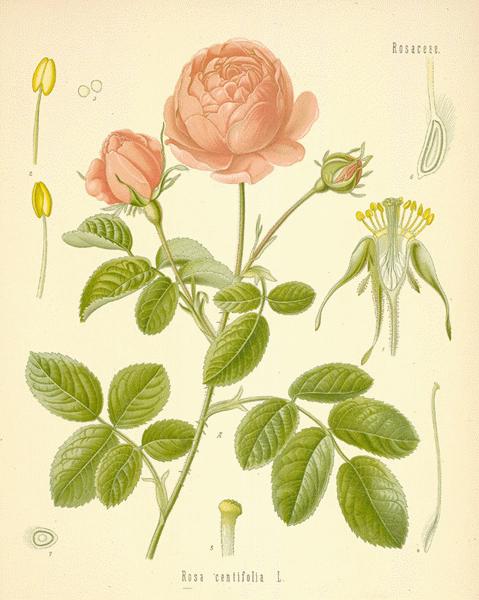 Source
SourceR. centifolia is cultivated in Provence, Turkey and Tunis; it has been found wild in the forests of the Caucasus, where double-flowered specimens are often met with.
A small amount of Otto of Roses has been produced in the South of France for at least 150 years, having been an established industry there before the French Revolution, but these earlier French ottos, almost entirely derived from R. centifolia, as a by-product in rose-water distillation, were consumed in the country itself. French roses were almost exclusively used for the manufacture of rosepomade and of rose-water, the French rosewater having the reputation of being superior in odour to any that can be produced in England. In spite of their unrivalled delicacy of fragrance, which always commanded a high place in the estimation of connoisseurs, until recent years the high price and lack of body of French ottos did not enable them to compete for general purposes with the Balkan concrete oil. When, however, Bulgaria joined the Central Empires, the French seized their opportunity, and methods of distillation were modernized, improved stills were erected and many other blooms than those of R. centifolia were experimented with, until now French otto has made itself a place in perfumery. Large plantations of roses have been laid down, and the output of otto is increasing steadily, 10,000 to 20,000 OZ. being at present the annual production. French chemists, botanists and horticulturists have studied the scientific aspect of the Rose, and in the new roses introduced, the chief object has been to improve the odour rather than the appear ance of the flower. The variety of rose mostly cultivated is the Rose de Mai, a hybrid of R. gallica and R. centifolia, bearing recurved prickles on the flowering branches. Two types are grown in the Grasse district, one more spiny than the other. They are mingled in the plantations, but the more spiny is preferred for less irrigated ground and the one with fewer thorns for wellwatered land. The bushes are planted half a metre apart, in rows one metre asunder. The first fortnight in May sees the rose harvest. The buds open gradually and are numerous, as each stalk bears a dense cluster and all the annual stems are well-covered. In the second half of May, after flowering, they are cut back and the complete pruning takes place in the following November. A rose plantation lasts from eight to ten years. Five thousand rose-trees will occupy about 1/2 acre of land and will produce about 2,200 lb. of flowers during the season. It is necessary to distil about 10,000 lb. of roses to obtain 1 lb. of oil. By the volatile solvents process a similar quantity will give anything up to 10 lb. of concrete.
A small amount of Otto of Roses has been produced in the South of France for at least 150 years, having been an established industry there before the French Revolution, but these earlier French ottos, almost entirely derived from R. centifolia, as a by-product in rose-water distillation, were consumed in the country itself. French roses were almost exclusively used for the manufacture of rosepomade and of rose-water, the French rosewater having the reputation of being superior in odour to any that can be produced in England. In spite of their unrivalled delicacy of fragrance, which always commanded a high place in the estimation of connoisseurs, until recent years the high price and lack of body of French ottos did not enable them to compete for general purposes with the Balkan concrete oil. When, however, Bulgaria joined the Central Empires, the French seized their opportunity, and methods of distillation were modernized, improved stills were erected and many other blooms than those of R. centifolia were experimented with, until now French otto has made itself a place in perfumery. Large plantations of roses have been laid down, and the output of otto is increasing steadily, 10,000 to 20,000 OZ. being at present the annual production. French chemists, botanists and horticulturists have studied the scientific aspect of the Rose, and in the new roses introduced, the chief object has been to improve the odour rather than the appear ance of the flower. The variety of rose mostly cultivated is the Rose de Mai, a hybrid of R. gallica and R. centifolia, bearing recurved prickles on the flowering branches. Two types are grown in the Grasse district, one more spiny than the other. They are mingled in the plantations, but the more spiny is preferred for less irrigated ground and the one with fewer thorns for wellwatered land. The bushes are planted half a metre apart, in rows one metre asunder. The first fortnight in May sees the rose harvest. The buds open gradually and are numerous, as each stalk bears a dense cluster and all the annual stems are well-covered. In the second half of May, after flowering, they are cut back and the complete pruning takes place in the following November. A rose plantation lasts from eight to ten years. Five thousand rose-trees will occupy about 1/2 acre of land and will produce about 2,200 lb. of flowers during the season. It is necessary to distil about 10,000 lb. of roses to obtain 1 lb. of oil. By the volatile solvents process a similar quantity will give anything up to 10 lb. of concrete.


No hay comentarios.:
Publicar un comentario